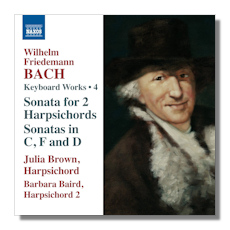
The Internet's Premier Classical Music Source
Related Links
- W.F. Bach Reviews
- Latest Reviews
- More Reviews
-
By Composer
-
Collections
DVD & Blu-ray
Books
Concert Reviews
Articles/Interviews
Software
Audio
Search Amazon
Recommended Links
Site News
 CD Review
CD Review
Wilhelm Friedemann Bach

Keyboard Works 4
- Sonata for Harpsichord in D Major, F 3
- Sonata for Harpsichord in C Major, F 1
- Concerto for 2 Harpsichords solo in F Major, F 10 *
- Sonata for Harpsichord in F Major, F 202
Julia Brown, harpsichord
* Barbara Baird, harpsichord
Naxos 8.573027
The music of Wilhelm Friedemann Bach (1710-1784), Johann Sebastian's second child and eldest son, has a distinct and beguiling quality to it. The four keyboard works on this attractive new CD from Naxos, for instance, suggest a major, confident, composer fully aware of the serious, contrapuntal pre-occupations of his father; yet one anxious to write in the newer, more purely melodic galant style, which was at its height during his lifetime. One might go further, and say, that whatever you're expecting from this CD before you listen to it, you'll be surprised. You'll get more.
Volumes 1 and 2 (8.557966 and 8.570530) were released as long ago as 2007 and 2008 with Robert Hill and Julia Brown respectively. In 2012 Classical Net responded positively to Volume 3 (Naxos 8.572814) in this series by Brown alone. Here she is joined by Barbara Baird in the opening work – a "concerto" (really a more substantial sonata) – on this fourth CD in the series.
The playing of both Brown and Baird is full of life and attack, humor and confidence: listen to the muscularly-arpeggiated runs in the presto[tr.3] of that F Major work (F 10), for example. It's not exactly carefree extrovert expression because it leaves room for the listener's response. It's inviting and even mildly quizzical. Yet authoritative in just that way that we need it to be. On the other hand, when depth of feeling, reflection and tarrying are required, as in the gorgeous adagio of the D Major (F 3 [tr.11]), Brown is able to bring to bear an attentiveness, closeness and affection for the music which really makes one stop and think.
Brown's articulation is as clean as it's expressive. Her harpsichord has a particularly neat and penetrating tone. She plays the C Major (F 1b, [tr.s 4-6]) with a superb sense of structure and architecture; and sense of why, as well as how, it should develop – and does. Da Capo passages are never perfunctory; and the melodic ideas seem to unfold with a pleasing inevitability. At the same time, her phrasing does not relax into the less demanding technicalities of the galant style. Counterpoint has been replaced by music whose line still invites the kind of anticipation to which her relaxed yet competent style is well suited. On the other hand, the D Major (F 3 [tr.s 10-12]) makes greater technical demands; it reaches into what seems like more personal territory for W.F. Bach. His first publication, it is also the longest on the CD, at almost half an hour with the aforementioned adagio [tr.11], remarkably, the longest.
The F Major (F 202 [tr.s 7-9] displays yet another characteristic: Friedemann's gift of contrast, variety, the unexpected – even while working in the context of the emergent Sonata Form. The composer is not playing, though the ideas are at times playful – and executed with appropriate high spirits. Sharing not a little with the exuberance of Domenico Scarlatti's style for solo keyboard, this work was also early in the younger composer's career. It derives some of its material from Friedemann's father. But its invention and confidence are all his own. It's in keeping with Brown's approach to this project that the three movements are each played for their own sake. It's respected as its own composition, anchored in itself. Indeed, one could easily have lost all sense of W.F. Bach's strengths as a composer by placing him after his father and before Classicism. Instead, Brown and Baird approach the music in its own right. The world of the solo keyboard (or two keyboards in concert in F 10) has no need of spurious expansion in these players' conception. Musicality, delight, gentility and vigor abound. They bring out all the qualities, quite possibly just as the composer imagined them.
The acoustic on the CD (that of the Beall Concert Hall, University of Oregon) is warm and open. It's ideally suited to two aspects, in particular, of these modern instruments (by Richard Kingston [Brown's], and Keith Hill [Baird's] after Mietke 1710) which both support the players' conception of the compositions: the rather stately overall projection of dynamic range and their rich timbre; and a quiet determination never to obscure the most minute and particular detail. The booklet for the CD is the customary three-page fold-out with details (by Brown herself) in English and German of the pieces and brief players' biographies. If you're collecting this series, don't hesitate. This is a splendid addition. If you're as yet unaware of the strengths of Friedemann, it's likely that the quality of Brown's and Baird's playing will tempt you to explore the earlier releases. And keenly await the next. While you may initially approach the music as a polished chandelier through which to observe the ballrooms of Dresden, Halle and Berlin, your focus soon rests on the colors and texture of the glass itself.
Copyright © 2013, Mark Sealey





















